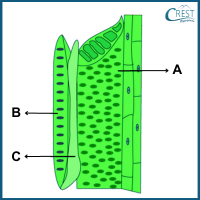1. Identify A, B, and C in the following diagram.

a) A: Vessels, B: Sieve Tubes, C: Xylem Fibres
b) A: Sieve Tubes, B: Phloem Fibres, C: Phloem Parenchyma
c) A: Xylem Parenchyma, B: Vessels, C: Xylem Fibres
d) A: Vessels, B: Tracheids, C: Xylem Fibres
Answer: d) A: Vessels, B: Tracheids, C: Xylem Fibres
2. In a study, scientists removed a ring of bark (phloem) from around the trunk of a tree. Over time, the portion of the tree located above the removed bark began to die. Which vital function of the phloem was the primary cause of this phenomenon?
a) Water transport
b) Nutrient storage
c) Mechanical support
d) Organic nutrient transport
Answer: d) The primary function of the phloem is to transport organic nutrients, specifically the products of photosynthesis (mainly sugars), from the leaves where they are produced to other parts of the plant where they are needed for growth, storage, and metabolism. This transport of nutrients is bidirectional and occurs through structures called sieve tubes.
When a ring of bark (phloem) is removed from around the trunk of a tree, it disrupts the flow of these essential nutrients from the leaves to the rest of the plant. As a result, the portion of the tree located above the removed bark is deprived of the sugars and other nutrients necessary for its survival and growth.
3. In the following question, you will find an assertion and a reason. Select the appropriate option that applies.
Assertion: The primary function of meristematic tissues is to enable plant growth in length and girth.
Reason: Meristematic tissues are regions of actively dividing cells that contribute to the production of new cells, allowing the plant to increase in size and complexity.
a) Both the assertion and reason are true, and the reason is a correct explanation of the assertion.
b) Both the assertion and reason are true, but the reason is not a correct explanation of the assertion.
c) The assertion is true, but the reason is false.
d) The assertion is false, but the reason is true.
Answer: a) The assertion correctly states that the primary function of meristematic tissues is to enable plant growth in length and girth. These tissues are responsible for continuous cell division, which leads to the formation of new cells and tissues, resulting in plant growth. The reason provided further explains that meristematic tissues consist of actively dividing cells that contribute to the production of new cells, which indeed allows the plant to increase in size and complexity. Therefore, both the assertion and the reason are true, and the reason provides a correct explanation of the assertion.
4. In a study comparing two types of wood, researchers found that Wood Type A had larger vessels and more porous xylem tissue, while Wood Type B had smaller vessels and denser xylem tissue. Which of the following statements about Wood Type A is most likely true?
a) It is from a desert plant adapted to conserve water.
b) It is from a tree that grows in a temperate rainforest.
c) It is from a plant with high resistance to pests.
d) It is from a tree with a shallow root system.
Answer: b) It is from a tree that grows in a temperate rainforest.
Wood Type A having larger vessels and more porous xylem tissue is an adaptation that facilitates efficient water transport. This adaptation is commonly observed in trees from environments with high water availability, such as temperate rainforests. In such regions, trees need to efficiently transport large amounts of water to support their rapid growth and development.
Option (a) is less likely to be true since desert plants tend to have adaptations that conserve water, such as smaller vessels and less porous xylem tissue.
Option (c) is not directly related to the characteristics of xylem tissue and
Option (d) is also less likely to be true since a tree with a shallow root system might not necessarily have larger vessels and more porous xylem tissue.
5. In agriculture, grafting is commonly used to combine the desirable traits of two different plants. Which type of plant tissue is responsible for the successful fusion of tissues during grafting?
a) Ground tissue
b) Meristematic tissue
c) Dermal tissue
d) Vascular tissue
Answer: b) Meristematic tissue is responsible for cell division and growth in plants. During grafting, it is the meristematic tissue that enables the successful fusion of tissues from two different plants. This tissue allows for the formation of new connections and integration between the vascular tissues of the two plants, leading to the growth and development of a combined plant with desirable traits.


